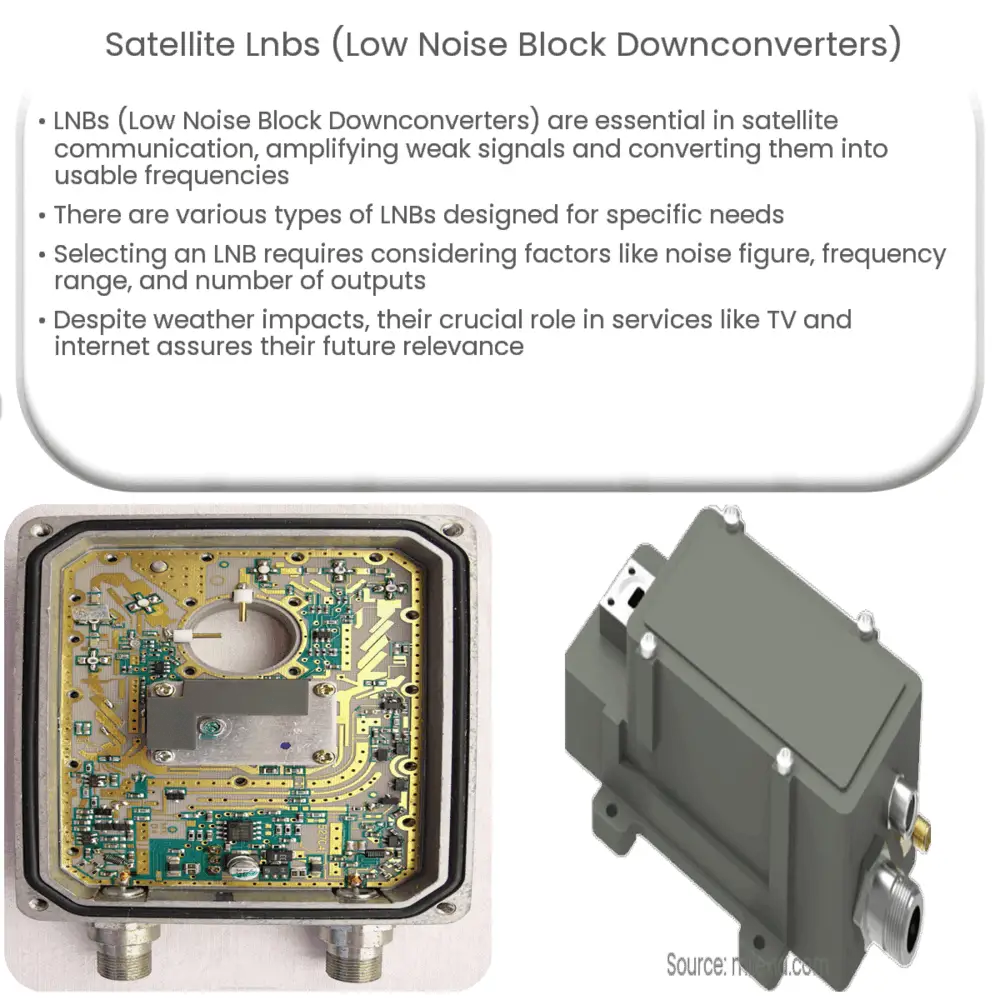Explore the essential role of Low Noise Block Downconverters (LNBs) in satellite communication, their types, and selection tips.

Understanding Satellite LNBs (Low Noise Block Downconverters)
Satellite communication has been at the forefront of technology, allowing us to communicate over vast distances, track weather patterns, and even explore distant corners of our universe. At the core of this technology are critical components known as LNBs or Low Noise Block Downconverters. The purpose of an LNB is to amplify the signal received from a satellite, while at the same time reducing noise interference, thus ensuring a clear and reliable signal transmission.
What is an LNB?
An LNB, or Low Noise Block downconverter, is a critical device in the dish antenna system, usually situated at the focal point of the dish. It serves a two-fold purpose: to amplify the signals received from a satellite, and to convert these high-frequency signals into lower frequency signals that can be processed by a television receiver or a set-top box.
The Working Principle of LNBs
The principle behind an LNB is based on the conversion of high-frequency satellite signals into lower frequency signals. When a satellite signal reaches the dish, it is reflected towards the LNB. This signal, typically in the microwave frequency range, is then captured and processed by the LNB.
- Amplification: The received signals are weak due to the large distances they travel. Hence, they need to be amplified. This is achieved by a device within the LNB called the low noise amplifier (LNA).
- Downconversion: The amplified signals are then subjected to a downconversion process. A local oscillator within the LNB generates a specific frequency that is mixed with the incoming signal, resulting in a lower frequency signal.
Variations of LNBs
There are several types of LNBs available, each designed for a specific requirement or satellite communication setup. They differ in their noise factor, local oscillator frequency, the number of outputs they offer, and their overall design.
- Universal LNB: This is the most commonly used LNB type, capable of receiving two distinct frequency bands from satellites.
- Quattro LNB: A Quattro LNB has four outputs, each providing a specific band or polarization. This type is generally used for commercial installations.
- Monoblock LNB: This LNB type is essentially two or more LNBs built into one unit, allowing reception from multiple satellites without the need for multiple dishes.
Factors to Consider When Selecting an LNB
Choosing the right LNB for your satellite setup is crucial to ensure the best signal quality. Here are some factors you should consider when selecting an LNB:
- Noise Figure: The noise figure is a measure of the noise produced by the LNB itself. Lower noise figures result in better signal quality.
- Frequency Range: Different LNBs are designed to receive different frequency ranges. The frequency range of the LNB should match the satellite’s broadcast frequency.
- Number of Outputs: The number of outputs determines how many receivers can be connected to the LNB. For example, if you want to connect multiple televisions to your satellite dish, you’ll need an LNB with multiple outputs.
Impact of Weather on LNB Performance
While LNBs are designed to operate in various weather conditions, severe weather can impact their performance. Heavy rain, snow, or even a buildup of dew can block the signal between the satellite and the LNB, leading to signal degradation or loss. Some modern LNBs are built with weather protection to combat these issues, but regular maintenance and cleaning are still recommended.
The Role of LNBs in Satellite Communication
Regardless of the specific type or configuration, the LNB remains a fundamental component in satellite communication. Without an LNB, the weak signals emitted from satellites in space would be too low to process effectively. By amplifying these signals and converting them to a frequency that our television receivers or set-top boxes can process, LNBs allow us to enjoy a variety of satellite services, from television programming to internet access.
Conclusion
In conclusion, Low Noise Block Downconverters (LNBs) are pivotal in satellite communication, amplifying weak signals and downconverting them to usable frequencies. There are various types of LNBs available, each designed to cater to specific needs. Understanding how an LNB works and what factors to consider when selecting one can drastically improve the quality of your satellite-based services. Despite the rise of various communication technologies, the integral role of LNBs assures their relevance in the foreseeable future.


